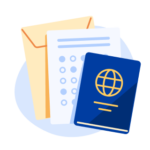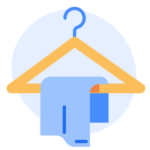The first year of living and studying abroad is often the hardest for international students. Not only are you living far from home, you need to deal with a lot of paperwork and arrangements. And that’s before you even start your first class!
Every situation is different, but there are some important things every international student needs to remember to include in their packing list for Canada. Bring the 10 items on our university study abroad checklist below, and you’ll be set up for an awesome first year of studies.
Try ApplyBoard’s free-to-use platform to find a study program that fits your needs.
Watch our University Checklist video!
10. Funds for Living Expenses
Having accommodations secured before you land in Canada is essential. For one thing, you don’t want to be scrambling to find a place to live after your classes start. More importantly, border officers will ask you about where you’ll be living, and can turn you away if you don’t have housing arranged. So, it’s important you have your full accommodation information ready, including the address, when entering Canada.
You’ll also need to prove you can support yourself financially while you study. As of January 1, 2024, all international students living in Canada must prove they have access to a minimum amount of C$20,635 for their living expenses. This is in addition to being able to pay for your tuition fees.
The minimum financial requirement amount is set in line with the cost of living, and is updated regularly by the Government of Canada. It’s scheduled to increase to C$22,895 on September 1, 2025.
9. Funds for Tuition
As mentioned above, you’ll need to prove to the Canadian government that you can pay the tuition fees for your study program. At the post-secondary level, international student tuition at the undergrad level can cost from C$15,000 to over C$60,000 a year.
If you’d like to pay for your tuition from outside of Canada, bank drafts or money orders (in Canadian dollars) are accepted by most universities and colleges.
Guaranteed Investment Certificates (GICs) can strengthen your study permit application by proving your financial means. Find out more about GICs for international students.
8. Winter Clothes
You’ve likely heard that Canada gets really cold in the winters! In Toronto, which is actually one of Canada’s warmer cities in the winter, the average temperature in January is about -5.5°C (22°F). It’s not uncommon to see the temperature drop to -20°C or even colder.
A winter coat, warm boots, winter hats like a tuque, and insulated gloves are important, as they can help you stay warm in the cooler months. However, if buying winter clothes is trickier in your home country, you can wait to buy these things until you’re in Canada.
If you live in southern British Columbia, you might not need to buy as many winter clothes, as this region doesn’t get as cold as the rest of Canada. However, if you’re studying anywhere else, you’ll need to bundle up!

7. Canadian Bank Account
One of the first things you should do after you arrive in Canada is open a Canadian bank account. Doing so will help you manage your money, and make it easier to collect income if you end up working in Canada while you’re studying. Opening an account may seem overwhelming at first, but it’s fairly easy to do.
We recommend looking for student banking plans, and ideally opening a no-fee chequing account. You may also want to find a bank that offers services in your first language if you’re still learning English or French.
Check out our step-by-step guide to opening a student bank account in Canada.

6. Tech and Gadgets
The most important piece of technology you’ll want to own while studying in Canada is a smartphone. Whether you bring a phone from home or purchase one once you arrive, you’ll need to get a phone plan from a Canadian phone company during your stay. Canadians pay some of the highest mobile fees in the world, but there are many great deals available to students, especially in the fall as classes start. We recommend shopping around to find one that fits your budget. Laptops can be a great investment, and are helpful for writing papers or assignments and taking notes.
If you’re bringing any electronics from home, make sure they’re compatible with Canadian outlets (Types A and B) and voltage (120 V). If not, you’ll also need adapters so you can use your electronics safely.

5. Emergency Contact List
Studying abroad will be the first time many international students live away from home. For this reason, we’ve included emergency contacts in our study abroad checklist. It’s a good idea to share your list of emergency contacts with a trusted friend, and your roommates, if you have them. This list should include your parents or guardians, and any responsible siblings. It can also include a people you know and trust who live locally and can help out if you have an emergency.
Make sure you have both physical and digital copies (email the list to yourself) to avoid losing it.
Check out our four ideas to help you conquer homesickness when studying abroad.

4. Government ID
Next on our study abroad checklist is government ID. Your passport isn’t the only proof of identity you’ll need as an international student. While your passport will let you travel internationally, it’s a good idea to include every piece of official ID you can, like a driver’s license and birth certificate, in your packing list for Canada.
Make copies of all of these documents before you leave your home country, and leave them with your parents or guardians or in another secure location.
Also, you’ll want to ensure your passport is valid for at least six months past your date of arrival. In fact, it’s ideal if your passport is valid for the full duration of your study period.

3. Insurance
All international students in Canada must have Canadian health insurance. Health insurance could save your finances (and your life) in the event of a medical emergency.
In some provinces and territories, international students may be eligible for provincial health care programs, where in others, you’ll need to buy private insurance. So, check with your institution to find out what’s required.
Looking for more general student life advice after you land in Canada? Check out our helpful arrival guide.
2. Medical Records and Prescriptions
Before you get insurance, make sure your medical records and prescriptions are in order. Your college or university will outline which documents you’ll need to bring, which may include your medical, dental, or vaccination records.
Depending on where you’re moving from, you may need to pass a medical exam before you’re allowed to enter Canada. Making sure your vaccinations are up-to-date (by Canadian standards) is also essential.
If you have any prescriptions, ensure you have enough to cover you when you first arrive in Canada. There is a chance your exact medication won’t be available in Canada, so check with your doctor or specialist about generic or alternate options. Always research in advance to see what your options are, but in many cases, it should be quick and easy to renew your prescriptions.

1. Letter of Acceptance and Provincial or Territorial Attestation Letter
The final items on our study abroad checklist are your letter of acceptance (LOA) and provincial or territorial attestation letter (PAL/TAL). Your letter of acceptance is more than just your confirmation of enrolment at a Canadian school; it’s required to get your study permit.
As of 2024, most international students must also include a Provincial Attestation Letter (PAL) or Territorial Attestation Letter (TAL) with their study permit application. The PAL or TAL certifies that you’ve been assigned one of the available spaces to study in that province or territory.
To attain your study permit, you’ll need to present your original acceptance letter and PAL or TAL (unless you’re PAL-exempt) with your application, and again as you first enter Canada. In other words, you’ll need a printed copy of your original acceptance letter and your PAL or TAL when you arrive in Canada. Don’t forget them!
For more information on documents you’ll need for a Canadian student visa, read our guide on what you’ll need to study in Canada.
We hope this study abroad checklist helps you prepare for your first year as an international student. Best of luck!
Ready to start your study abroad journey? Create your free ApplyBoard account today!





